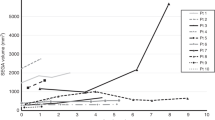Abstract
Purpose
The most common neurological complications associated with tuberous sclerosis complex (TSC) include intractable seizures that begin in infancy and subependymal giant cell astrocytoma (SEGA) complicated by hydrocephalus with increasing age. Information on SEGA growth of TSC patients is limited. This study aimed to examine the TSC-SEGA growth rates by periodic neuroimaging.
Methods
This study evaluated the TSC-SEGA growth rates by serial neuroimaging. Fifty-eight patients with TSC underwent systematic evaluation, including a review of medical history and serial brain neuroimaging.
Results
While magnetic resonance imaging was more sensitive in detecting cortical tubers than computed tomography (73.1 vs. 0 %, p < 0.001), its efficacy in identifying intracranial lesions was comparable to that of computed tomography (96.2 vs. 100 %, p = 0.658). Significant tumor growth was observed in children (p = 0.012) and adults (p = 0.028) during follow-up periods, respectively (median for children 23.5 months, interquartile range 18–40 months and median for adults 23 months, interquartile range 12–34 months). Further, the SEGA growth rate in children was significantly higher than that in adults (75.6 vs. 16.5 %, p = 0.03).
Conclusions
The results of the study show that SEGA has a significantly higher growth rate in children using serial follow-up brain imaging, suggesting the importance of performing follow-up neuroimaging at yearly intervals in childhood to identify and prevent potential comorbidities.



Similar content being viewed by others
References
Rieger E, Kerl H (1992) The clinical spectrum of organ manifestations of tuberous sclerosis. Hautarzt 43(5):272–277
Tan TK, Chen FL, Sheu JN, Chen SM, Huang HH, Tsai JD (2014) Tuberous sclerosis complex associated with heterotopic ossification in a young girl. Pediatr Neonatol 55(1):65–77
Tsai JD, Wei CC, Chen SM, Lue KH, Sheu JN (2014) Association between the growth rate of renal cysts/angiomyolipomas and age in the patients with tuberous sclerosis complex. Int Urol Nephrol 46(9):1685–1690
Jay V (1999) Historical contributions to pediatric pathology: legacy of Dr. Ewing. Pediatr Dev Pathol 2(6):597–599
Staley BA, Vail EA, Thiele EA (2011) Tuberous sclerosis complex: diagnostic challenges, presenting symptoms, and commonly missed signs. Pediatrics 127(1):e117–125
Franz DN, Bissler JJ, McCormack FX (2010) Tuberous sclerosis complex: neurological, renal and pulmonary manifestations. Neuropediatrics 41(5):199–208
Christophe C, Sékhara T, Rypens F, Ziereisen F, Christiaens F, Dan B (2000) MRI spectrum of cortical malformations in tuberous sclerosis complex. Brain Dev 22(8):487–493
Hallett L, Foster T, Liu Z, Blieden M, Valentim J (2011) Burden of disease and unmet needs in tuberous sclerosis complex with neurological manifestations: systematic review. Curr Med Res Opin 27(8):157–183
Rosser T, Panigrahy A, McClintock W (2006) The diverse clinical manifestations of tuberous sclerosis complex: a review. Semin Pediatr Neurol 13(1):27–36
Roach ES, Sparagana SP (2004) Diagnosis of tuberous sclerosis complex. J Child Neurol 19(9):643–649
Roach ES, Gomez MR, Northrup H (1998) Tuberous sclerosis complex consensus conference: revised clinical diagnostic criteria. J Child Neurol 13(12):624–628
Northrup H, Krueger DA, International Tuberous Sclerosis Complex Consensus Group (2013) Tuberous sclerosis complex diagnostic criteria update recommendations of the 2012 international tuberous sclerosis complex consensus conference. Pediatr Neurol 49(4):243–254
Wataya-Kaneda M, Tanaka M, Hamasaki T (2013) Trends in the prevalence of tuberous sclerosis complex manifestations: an epidemiological study of 166 Japanese patients. PLoS One 8(5):e63910
Krueger DA, Northrup H (2013) Tuberous sclerosis complex surveillance and management: recommendations of the 2012 International Tuberous Sclerosis Complex Consensus Conference. Pediatr Neurol 49(4):255–265
Roth J, Roach ES, Bartels U, Jóźwiak S, Koenig MK, Weiner HL et al (2013) Subependymal giant cell astrocytoma: diagnosis, screening, and treatment. Recommendations from the International Tuberous Sclerosis Complex Consensus Conference 2012. Pediatr Neurol 49(6):439–444
Jóźwiak S, Nabbout R, Curatolo P (2013) Management of subependymal giant cell astrocytoma (SEGA) associated with tuberous sclerosis complex (TSC): clinical recommendations. Eur J Paediatr Neurol 17(4):348–352
Rovira À, Ruiz-Falcó ML, García-Esparza E, López-Laso E, Macaya A, Málaga I et al (2014) Recommendations for the radiological diagnosis and follow-up of neuropathological abnormalities associated with tuberous sclerosis complex. J Neurooncol 118(2):205–223
Adriaensen ME, Schaefer-Prokop CM, Stijnen T, Duyndam DA, Zonnenberg BA, Prokop M (2009) Prevalence of subependymal giant cell tumors in patients with tuberous sclerosis and a review of the literature. Eur J Neurol 16(6):691–696
Goh S, Butler W, Thiele EA (2004) Subependymal giant cell tumors in tuberous sclerosis complex. Neurology 63(8):1457–1461
Roach ES, Williams DP, Laster DW (1987) Magnetic resonance imaging in tuberous sclerosis. Arch Neurol 44(3):301–303
Inoue Y, Nemoto Y, Murata R, Tashiro T, Shakudo M, Kohno K et al (1998) CT and MR imaging of cerebral tuberous sclerosis. Brain Dev 20(4):209–221
Yates JR, Maclean C, Higgins JN (2011) Tuberous Sclerosis 2000 Study Group. The Tuberous Sclerosis 2000 Study: presentation, initial assessments and implications for diagnosis and management. Arch Dis Child 96(11):1020–1025
Nishio S, Morioka T, Suzuki S, Kira R, Mihara F, Fukui M (2001) Subependymal giant cell astrocytoma: clinical and neuroimaging features of four cases. J Clin Neurosci 8(1):31–34
Adriaensen ME, Zonnenberg BA, de Jong PA (2014) Natural history and CT scan follow-up of subependymal giant cell tumors in tuberous sclerosis complex patients. J Clin Neurosci 21(6):939–941
Altman NR, Purser RK, Post MJ (1988) Tuberous sclerosis: characteristics at CT and MR imaging. Radiology 167(2):527–532
Kotulska K, Józwiak S (2012) Subependymal giant cell astrocytoma: role of mTOR pathway and its inhibitors. In: Hayat MA (ed) Tumors of the central nervous system, vol 5. Springer, New York, pp 45–56
Acknowledgments
This work was supported by Chung Shan Medical University Hospital (CRDA001MIC03). Authors gratefully acknowledge the support of the Taiwan Tuberous Sclerosis Complex Association, the patients, and caregivers who participated in this survey.
Author information
Authors and Affiliations
Corresponding author
Ethics declarations
Conflict of interest
The authors have no conflicts of interest to disclose.
Rights and permissions
About this article
Cite this article
Tsai, JD., Wei, CC., Tsao, TF. et al. Association between the growth rate of subependymal giant cell astrocytoma and age in patients with tuberous sclerosis complex. Childs Nerv Syst 32, 89–95 (2016). https://doi.org/10.1007/s00381-015-2947-4
Received:
Accepted:
Published:
Issue Date:
DOI: https://doi.org/10.1007/s00381-015-2947-4




